|
جواب |
رسائل 1 من 279 في الفقرة |
|
Albert Einstein, German-born theoretical physicist and Nobel laureate (theory of relativity), born in Ulm, German Empire (d. 1955)
1879 Highlights
Day of the Week: Friday
How Long Ago? 142 years, 2 months and 10 days
Leap Year: No
https://www.onthisday.com/date/1879/march/14
FRIDAY=VENICE=VENUS=VIERNES
|
|
|
 أول أول
 سابق
265 إلى 279 من 279
لاحق سابق
265 إلى 279 من 279
لاحق
 آخر
آخر

|
|
جواب |
رسائل 265 من 279 في الفقرة |
|
“The city of birth will be as much a unique part of your life as your descent from your mother.”
Albert Einstein, 1929
ALBERT EINSTEIN IN ULM, 1879 – 1880
Hermann Einstein (1847-1902), born in Buchau on the Federsee and merchant in Ulm, married 18 year-old Pauline Koch (1858-1920) from Cannstatt, the daughter of a purveyor to the royal household and corn-merchant in Stuttgart, on August 8, 1876. At first Hermann Einstein and his young wife lived at the “Suedlicher Muensterplatz” in Ulm. He was the joint owner of a company trading with feather-beddings at Weinhof A 90 (“Zum Engländer”, later renamed to Weinhof 19). Ulm was then a soaring town of some 33000 inhabitants with two percent among them being Jews. The Einsteins, also being of Jewish ancestry, participated in the religious life of the Jewish community. In 1878/79 Hermann Einstein and his pregnant wife moved to a new and larger residence at Bahnhofstrasse B 135 (in 1880 renamed to Bahnhofstrasse 20) in Ulm.
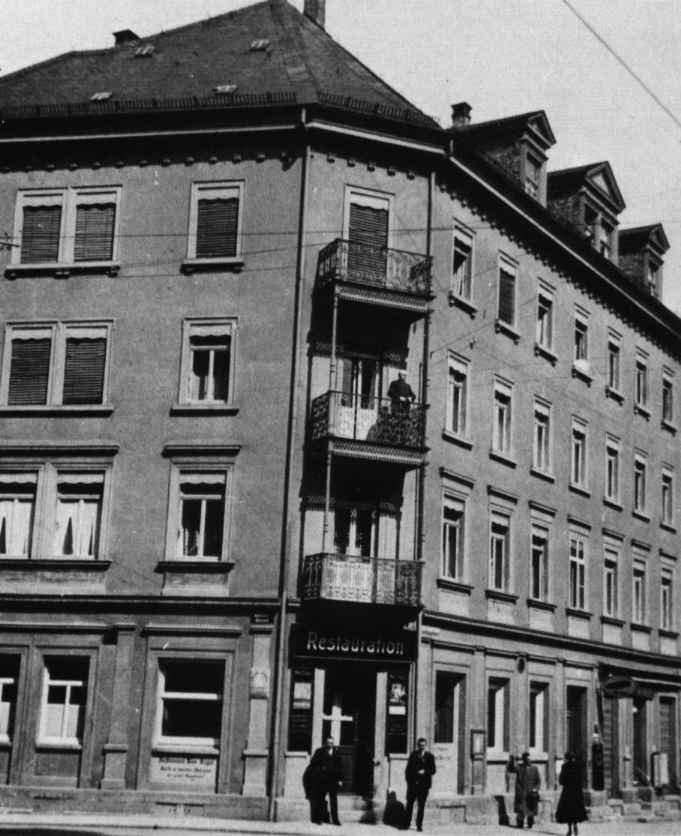 1 The house where Einstein was born
Einstein’s birth-place
About his birth-place in the Bahnhofstrasse 20, in a letter to Carlos Erlanger, son of the house-owner at that time, Einstein wrote in April 1929: “To be born the house is quite nice because on this occasion one does not yet have major aesthetic needs; instead one cries at his beloved ones without worrying much about reasons and conditions.”
The house, erected in 1871, was destroyed in December 1944 during one of the heaviest bombardments of Ulm. Einstein did not have any special relation to his birth-place. When he was shown a photo of his destroyed birth-place he wrote in his reply: “Time has affected it even much more than it has affected me.”
On March 14, 1879, a Friday, Pauline Einstein gave birth to her first child, a boy, in their residence in the Bahnhofstrasse. On the following day Hermann Einstein registered his son at the registry office in Ulm with the name Albert.
As the back of the head seemed much too big, the family initially considered a monstrosity. The physician, however, was able to calm them down and some weeks later the shape of the head was normal. When Albert’s grandmother saw him for the first time she is reported to have muttered continuously “Much too fat, much too fat!” Contrasting all apprehensions Albert grew and developed normally except that he seemed a bit slow.
Financially Hermann Einstein and his family were able to live a more or less untroubled life in Ulm. However, at the initiative of his younger brother Jakob, Hermann Einstein moved with his wife and the one year old Albert to Munich during the summer of 1880. There Hermann Einstein had the opportunity to become partner of his brother’s company Einstein & Cie. On June 21, 1880 Hermann Einstein registered himself and his family with the police. Thus after only 15 months Albert Einstein’s stay in Ulm had come to an end.
Until the present day it is not entirely clear whether Einstein ever visited his birth-place again. From several surviving letters, however, there is evidence that he might have visited Ulm briefly on passing through.
Ulm and Einstein
In 1920, after Einstein’s achievements had been widely recognized, Ulm also wanted to honour him. Thus, for example, in 1922 the decision was made to name a yet to be constructed street after him. Even though in Nazi-Germany this street was renamed Fichtestrasse (after Johann Gottlieb Fichte, 1762-1814, a German philosopher), it was named Einsteinstrasse again in 1945. On the occasion of his 50th birthday on March 14, 1929, Einstein was informed in a letter of congratulation by the then mayor that the city of Ulm had named a street in his honour. With respect to the Einsteinstrasse Einstein remarked in his reply: “I have already heard about the street named after me. My comforting thought was that I am not responsible for whatever is going to happen there.” Between 1920 and 1929 a lively exchange of notes between Ulm and Albert Einstein developed which, interrupted by the political situation in Germany, was only resumed in 1949.
In 1949 Ulm wanted to grant Einstein the rights of a freeman of the city. Einstein however declined, pointing to the fate of the Jews in Nazi-Germany.
While Einstein was still alive and also after his death in April 1955 several ceremonies and commemoration days were held in his honour.
At present, apart from the above-mentioned Einsteinstrasse, in Ulm you can find a memorial and a memorial tablet in the Bahnhofstrasse. In addition, the building of the “Volkshochschule” (school for adult education) carries the name “EinsteinHaus”. When laying the foundation-stone to the “EinsteinHaus – Haus der Volkshochschule” in January 1966 the nobel laureates Max Born (1882-1970), Otto Hahn (1879-1968) and Werner Heisenberg (1901-1976) were present. Since 1968 there is a permanent photographic exhibition in the first floor of the EinsteinHaus where the life of Albert Einstein is re-traced in a selection of individual photographs, arranged by Professor Hans (Nick) Roericht. Information about this exhibition is available under info@vh-ulm.de.
On the occasion of the 125th birthday of Albert Einstein a ceremonial act took place in the Congress Centre in Ulm on Sunday, March 14, 2004. After the lord mayor Ivo Gönner welcomed the audience, Johannes Rau, the prime minister of Baden-Württemberg Erwin Teufel and the head of the “Deutsche Physikalische Gesellschaft” (German Physical Society), professor Roland Sauerbrey held a speech. The ceremonial speech was held by doctor Albrecht Fölsing. The ceremonial act was musically accompanied by the Philharmonic Orchestra of the city of Ulm under the direction of James Allen Gähres.
The spring congress of the “Deutsche Physikalische Gesellschaft e.V.” (German Physical Society (incorporated society)) took place in Ulm in March. An Einstein opera was played in the “Grosses Haus” (Great House) of the Ulm Theatre from March to May. The cultural highlight of the Einstein year in Ulm, an Einstein exhibition, was presented in the town house on Muensterplatz from March 12 to August 29.
https://einstein-website.de/en/ulm/ |
|
|
|
جواب |
رسائل 266 من 279 في الفقرة |
|
|
|
|
جواب |
رسائل 267 من 279 في الفقرة |
|
|
|
|
جواب |
رسائل 268 من 279 في الفقرة |
|
|
|
|
جواب |
رسائل 269 من 279 في الفقرة |
|
Does space "flow" like a river? There's an analogy in General Relativity ... Why The Theory of Relativity Doesn't Add Up (In Einstein's Own Words).
|
|
|
|
جواب |
رسائل 270 من 279 في الفقرة |
|
Does space "flow" like a river? There's an analogy in General Relativity ... Why The Theory of Relativity Doesn't Add Up (In Einstein's Own Words).
|
|
|
|
جواب |
رسائل 271 من 279 في الفقرة |
|
The string theory time travel paradox^2
Tanuj Handa
Tanuj Handa
IITR | IIT-BHU | USCT | Developing research and creativity quotient | Curious about life |
Fecha de publicación: 28 oct 2019
Time is like a river, it swifts and shores in one direction
This is a notion with which everyone must be familiar with, the obsession to know more about the universe and how things are happening the way they happen goes way back in 20,000 BC when cosmologist made attempts to describe the force which makes it all stable. Time is one leg of the chair of the universe in which we all stand, thus it is quite dangerous to tamper the force and experiment with it.
Consider this analogy of time and river, both have a unidirectional flow and we are just the boat sailing along whether be time or the river. Travelling backwards against the flow requires a lot of energy like what quoted by the theory of relativity E=mc^2 is the amount of energy we have to achieve, to begin with, time travel.
Now, as you might have a little idea about string theory, which discusses the how the river of time is divided into different streams and the stream which we get depends upon the actions we take in present.
From the concept of time travel, we can conclude that if we get enough energy we can flow back in time, but if we don't give it in the right direction, we might face consequences. Some of the hypothesis of the event that may follow are :
1. We can end up being an alternate form of reality ( the one we can't relate to from our past)
2. We might alter the space-time and end up having both the different reality come together
3. The concept to enter in an alternate reality may require more energy than to go in our reality of past, hence it might not be achieved
Following it all, it might be difficult to relate but consider like this, you have just started to move the boat against the stream but instead of going to the diversion from where you came in, you chose the alternate stream and thus you are in an alternate past. OR you try to go back to your path from where you came and suddenly the stream takes you to different diversion and you end up in an alternate reality of your time, both of which are equally exciting and terrifying.
My notion to say it as paradox square is because as both time travel and string theory are a big paradox in itself, it's quite difficult to imagine such an event to happen. The only way we can know it all when we get to know how to flow against the flow of time and look it all by ourselves.
https://www.linkedin.com/pulse/string-theory-time-travel-paradox2-tanuj-handa |
|
|
|
جواب |
رسائل 272 من 279 في الفقرة |
|
|
|
|
جواب |
رسائل 273 من 279 في الفقرة |
|
|
|
|
جواب |
رسائل 274 من 279 في الفقرة |
|
|
|
|
جواب |
رسائل 275 من 279 في الفقرة |
|
|
|
-
-
Illustration on the base of the obelisk, showing how it was raised into place in 1836
-
Hieroglyphs on the obelisk.
-
Hieroglyphs on the upper obelisk. The Pharaoh on his throne is portrayed at the top
The centrepiece of the Place de la Concorde is an ancient Egyptian obelisk decorated with hieroglyphics exalting the reign of the pharaoh Ramesses II. It is one of two which the Egyptian government gave to the French in the 19th century. The other one stayed in Egypt, too difficult and heavy to move to France with the technology at that time. On 26 September 1981 President François Mitterrand formally returned the title of the second obelisk to Egypt.[16]
The obelisk once marked the entrance to the Luxor Temple. The wali of Egypt, or hereditary governor, Muhammad Ali Pasha, offered the 3,300-year-old Luxor Obelisk as a diplomatic gift to France in 1829. It arrived in Paris on 21 December 1833. Three years later, it was hoisted into place, on top of the pedestal which originally supported the statue of Louis XV, destroyed during the Revolution. The raising of the column was a major feat of engineering, depicted by illustrations on the base of the monument. King Louis Philippe dedicated the obelisk on 25 October 1836.[17]
The obelisk, a yellow granite column, rises 23 metres (75 ft) high, including the base, and weighs over 250 tonnes (280 short tons). Given the technical limitations of the day, transporting it was no easy feat – on the pedestal are drawn diagrams explaining the machinery that was used for the transportation. The government of France added a gold-leafed pyramidal cap to the top of the obelisk in 1998, replacing the missing original, believed stolen in the 6th century BC.[18]
|
|
|
|
|
|
|
جواب |
رسائل 276 من 279 في الفقرة |
|
LAST UPDATED: 27 NOVEMBER 2024
You may know Paris for its cathedral Notre-Dame, the Eiffel Tower, its café culture and its amazing museums and art galleries. The French capital is also famous for its fantastic perspective that runs from the Louvre to La Défense. This is the ‘Voie Triomphale’, aka the Historical Axis of Paris.
This line is one of the most prestigious perspectives in the world. In fact, its design has inspired cities such as Buenos Aires, Washington DC, New Delhi and Canberra. In this article, we’ll learn more about the Historical Axis of Paris. We’ll discover the stunning monuments and I reveal to you some stunning facts.
What is the Historical Axis of Paris?
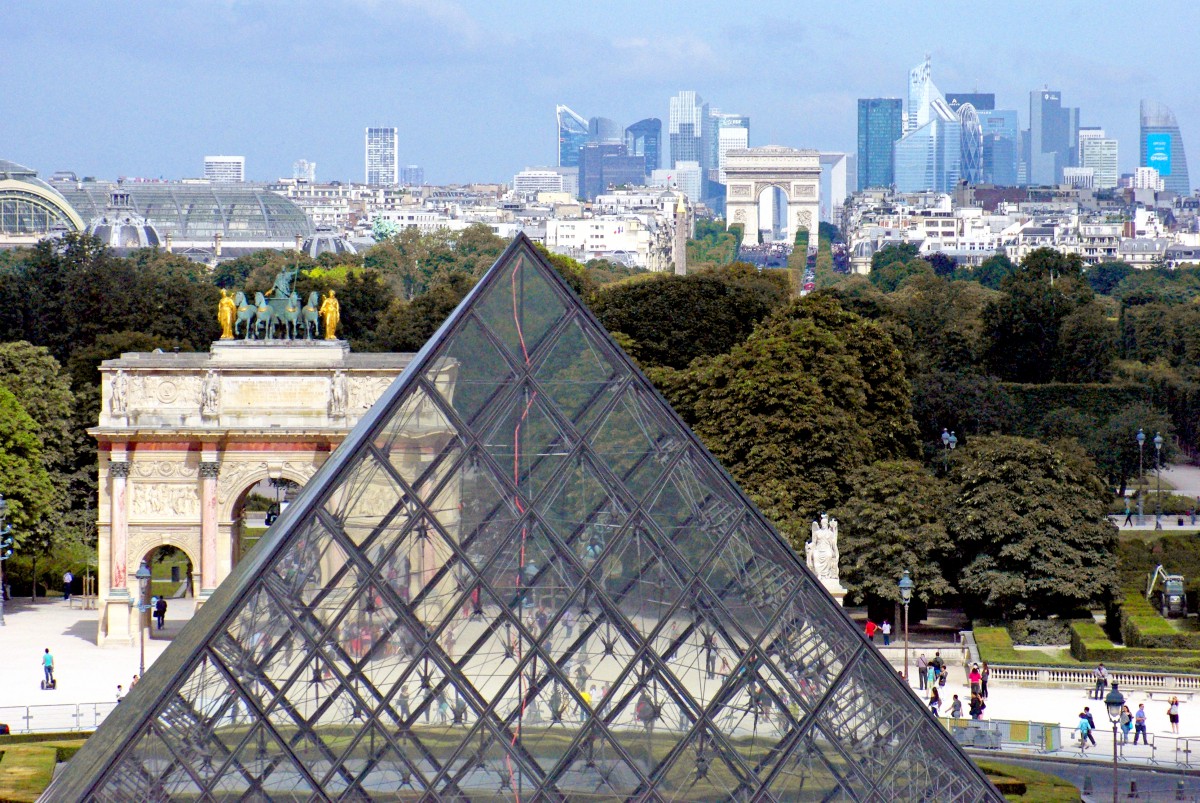 The glass pyramid and the historical axis of Paris © French Moments The glass pyramid and the historical axis of Paris © French Moments
The Historical Axis, also known in French as “Axe Historique”, “Voie Triomphale” or “Voie Royale” is orientated on a 26° angle.
It follows the course of the Sun from its rising in the East to its setting in the West.
Oddly, this angle of orientation is the same as that of Paris’ Notre-Dame Cathedral, some 1,000 metres away from the Louvre Palace.
More than just a series of monuments placed along the axis, it seems that a complex symbolism was at work in the mind of the successive urban planners.
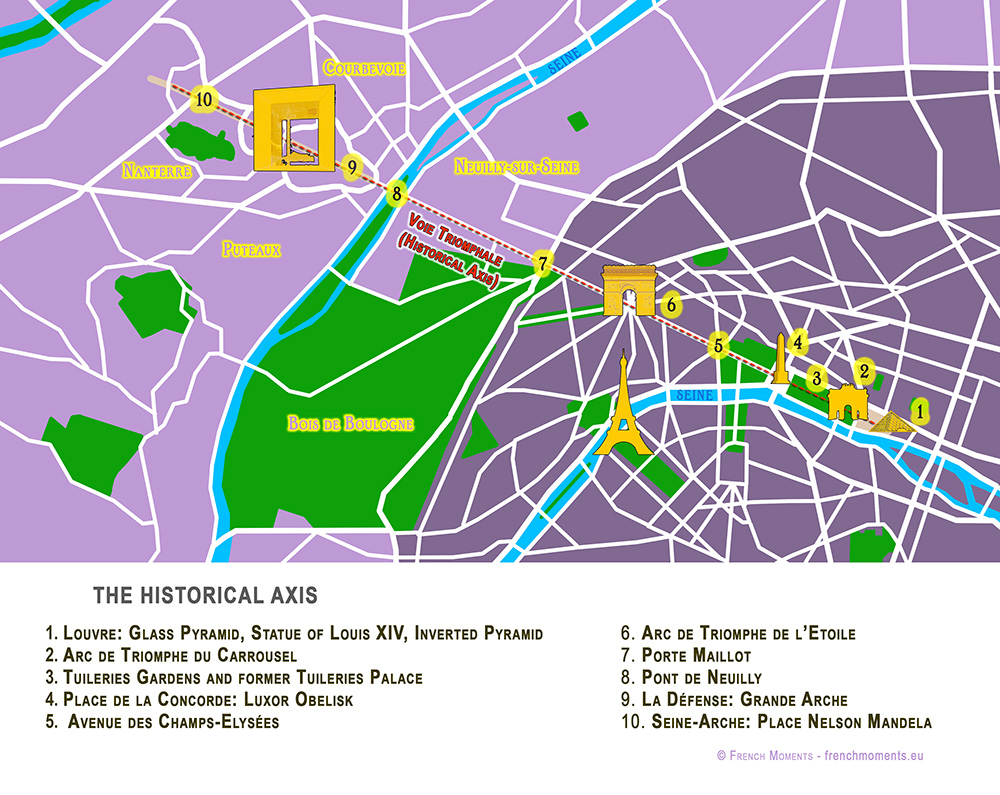
The Historical Axis runs through some of Paris’ most celebrated monuments and squares:
Let’s move along the Historical Axis of Paris, from East to West, starting from the Louvre.
The Palace of the Louvre
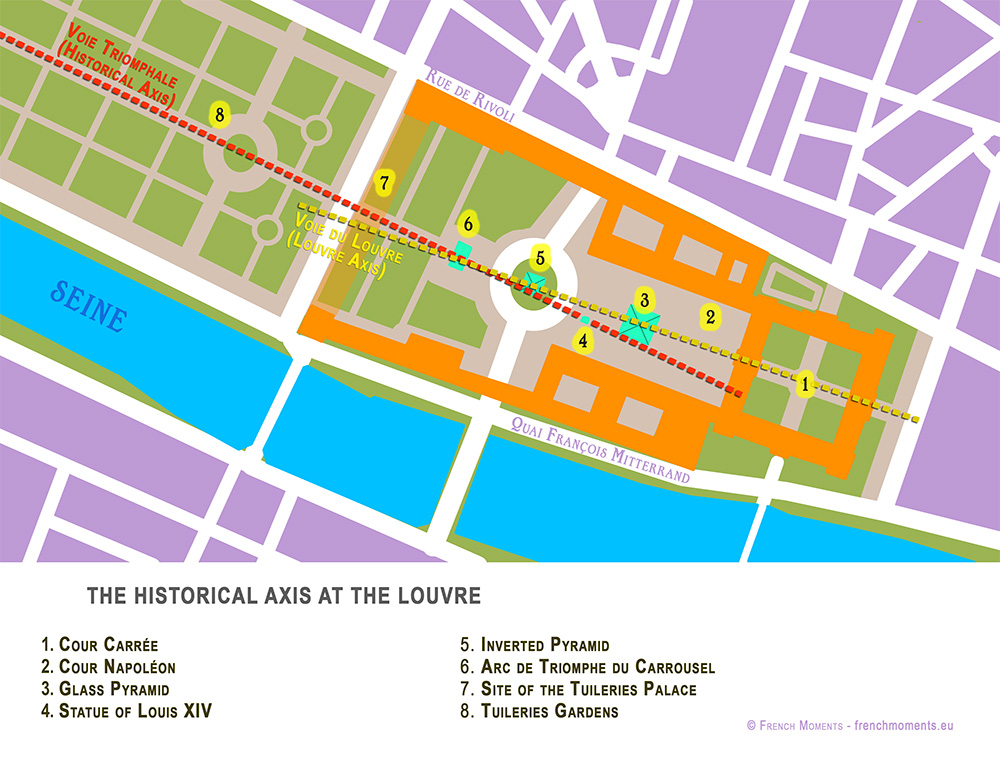
Today the great perspective starts at the Louvre, immediately beyond the Church of St Germain l’Auxerrois.
The crab-shaped Palace was the main residence of the kings of France until 1682, when Louis XIV, the ‘Sun King’, moved his court to Versailles. It currently houses one of the world’s most wonderful museums in a complex that is known as the “Grand Louvre”.
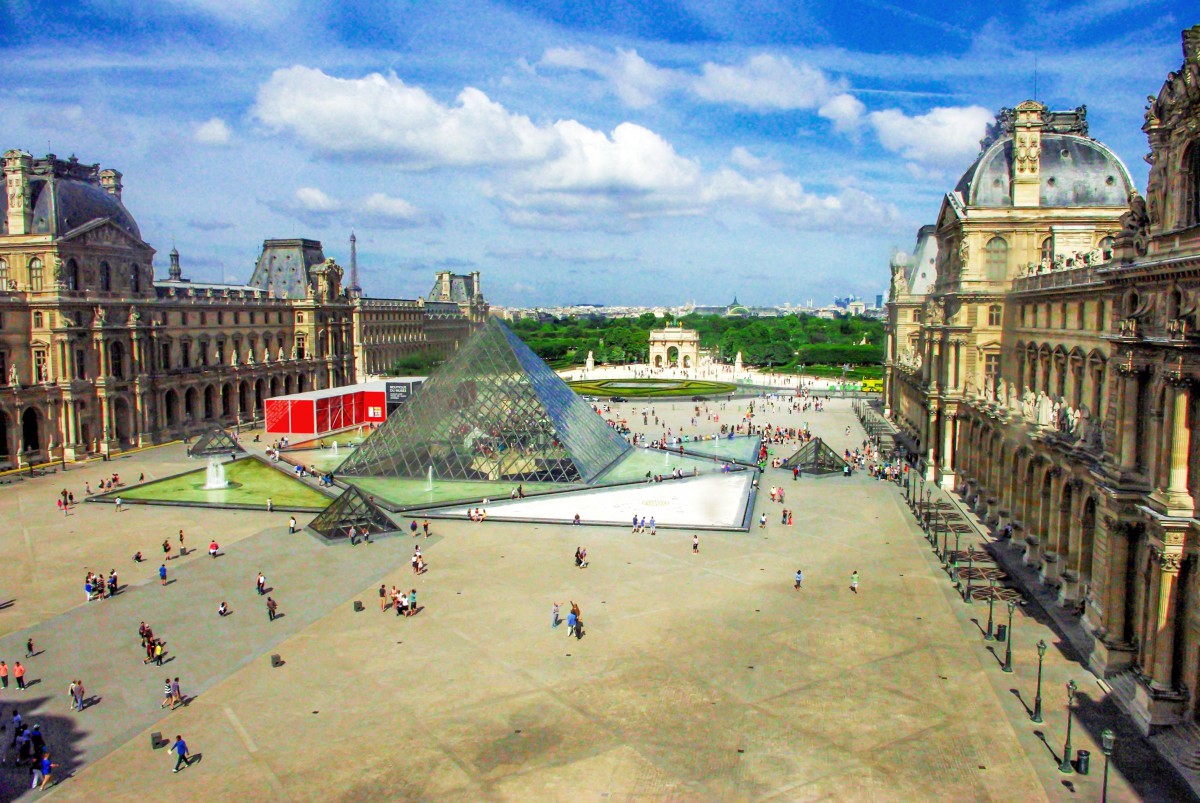 The Louvre today © French Moments The Louvre today © French Moments
The controversial glass pyramid of the Louvre
President François Mitterrand left his mark with his pharaonic project of “Le Grand Louvre”. He wished to complete it for the bicentennial celebration of the French Revolution in 1989. The titanic project comprised of major renovation works and the construction of a new landmark along the Historical Axis: the celebrated (and controversial) Glass Pyramid.
But if you look closer, you’ll notice that the glass pyramid is not aligned with the other monuments on the Historical Axis.
That’s why something had to be added in this vast courtyard of the Louvre…
https://frenchmoments.eu/historical-axis-of-paris-la-voie-triomphale/ |
|
|
|
جواب |
رسائل 277 من 279 في الفقرة |
|
LAST UPDATED: 27 NOVEMBER 2024
You may know Paris for its cathedral Notre-Dame, the Eiffel Tower, its café culture and its amazing museums and art galleries. The French capital is also famous for its fantastic perspective that runs from the Louvre to La Défense. This is the ‘Voie Triomphale’, aka the Historical Axis of Paris.
This line is one of the most prestigious perspectives in the world. In fact, its design has inspired cities such as Buenos Aires, Washington DC, New Delhi and Canberra. In this article, we’ll learn more about the Historical Axis of Paris. We’ll discover the stunning monuments and I reveal to you some stunning facts.
What is the Historical Axis of Paris?
 The glass pyramid and the historical axis of Paris © French Moments The glass pyramid and the historical axis of Paris © French Moments
The Historical Axis, also known in French as “Axe Historique”, “Voie Triomphale” or “Voie Royale” is orientated on a 26° angle.
It follows the course of the Sun from its rising in the East to its setting in the West.
Oddly, this angle of orientation is the same as that of Paris’ Notre-Dame Cathedral, some 1,000 metres away from the Louvre Palace.
More than just a series of monuments placed along the axis, it seems that a complex symbolism was at work in the mind of the successive urban planners.

The Historical Axis runs through some of Paris’ most celebrated monuments and squares:
Let’s move along the Historical Axis of Paris, from East to West, starting from the Louvre.
The Palace of the Louvre

Today the great perspective starts at the Louvre, immediately beyond the Church of St Germain l’Auxerrois.
The crab-shaped Palace was the main residence of the kings of France until 1682, when Louis XIV, the ‘Sun King’, moved his court to Versailles. It currently houses one of the world’s most wonderful museums in a complex that is known as the “Grand Louvre”.
 The Louvre today © French Moments The Louvre today © French Moments
The controversial glass pyramid of the Louvre
President François Mitterrand left his mark with his pharaonic project of “Le Grand Louvre”. He wished to complete it for the bicentennial celebration of the French Revolution in 1989. The titanic project comprised of major renovation works and the construction of a new landmark along the Historical Axis: the celebrated (and controversial) Glass Pyramid.
But if you look closer, you’ll notice that the glass pyramid is not aligned with the other monuments on the Historical Axis.
That’s why something had to be added in this vast courtyard of the Louvre…
https://frenchmoments.eu/historical-axis-of-paris-la-voie-triomphale/ |
|
|
|
جواب |
رسائل 278 من 279 في الفقرة |
|
Llama de la Libertad (París)
 La Llama de la Libertad, ofrecida al pueblo francés por donantes de todo el mundo como símbolo de la amistad franco-americana, en la plaza Diana (París).
La Llama de la Libertad (en francés, Flamme de la Liberté) de París es una réplica del mismo tamaño de la nueva llama situada en el extremo de la antorcha que lleva en la mano la Estatua de la Libertad de Nueva York desde 1986.1 El monumento, que tiene aproximadamente 3,5 metros de longitud, es una escultura de una llama de cobre dorado, apoyada en un pedestal de mármol gris y negro. Está situado cerca del extremo norte del puente del Alma, en la plaza Diana, en el distrito 8 de París, Francia.2
Fue ofrecida a la ciudad de París en 1989 por el International Herald Tribune en nombre de los donantes, que habían contribuido aproximadamente 400 000 dólares para su realización. Representaba la culminación de las celebraciones de 1987 del periódico por su cien aniversario de la publicación de un periódico en inglés en París. Más importante, la Llama era una muestra de agradecimiento por la restauración de la Estatua de la Libertad realizada tres años antes por dos empresas francesas que hicieron el trabajo artesanal del proyecto: Métalliers Champenois, que hizo el trabajo del bronce, y Gohard Studios, que aplicó el pan de oro. Aunque el regalo a Francia fue motivado por el centenario del periódico, la Llama de la Libertad es un símbolo más general de la amistad que une los dos países, igual que la Estatua de la Libertad cuando fue regalada a los Estados Unidos por Francia.
Este proyecto fue supervisado por el director de la unión de artesanos franceses en aquel momento, Jacques Graindorge. Propuso la instalación de la Llama de la Libertad en una plaza pública llamada Place des États-Unis en el distrito 16, pero el alcalde de París, Jacques Chirac, se opuso a esto. Tras un prolongado período de negociaciones, se decidió que la alama se situaría en una zona abierta cerca de la intersección de la Avenue de New-York y la Place de l'Alma. El monumento fue inaugurado el 10 de mayo de 1989 por Chirac.
En la base del monumento hay una placa conmemorativa que relata la siguiente historia:
"La Llama de la Libertad. Una réplica exacta de la llama de la Estatua de la Libertad ofrecida al pueblo de Francia por donantes de todo el mundo como símbolo de la amistad franco-americana. Con ocasión del centenario del International Herald Tribune, París 1887-1987."
La llama se convirtió en un monumento no oficial de Diana de Gales después de su muerte en 1997 en el túnel bajo el Pont de l'Alma.3 La llama es una atracción para turistas y seguidores de Diana, quiens pegan pósteres y folletos con material conmemorativo en la base. El antropólogo Guy Lesoeurs dijo que "la mayoría de las personas que vienen aquí piensan que se construyó para ella."2 La plaza del monumento se llama desde entonces Plaza Diana (París).
El monumento está cerca de la estación del Metro de París llamada Alma-Marceau en la línea 9 y de la estación Pont de l’Alma Línea 'C' del RER, así como por los buses número 42, 63, 72, 80, 92, y los autobuses turísticos Balabus.
El 14 de junio de 2008 se inauguró una nueva Llama de la Libertad, una escultura de Jean Cardot, que también simboliza las relaciones cálidas y respetuosas entre Francia y los Estados Unidos. Fue instalada en los jardines de la Embajada de los Estados Unidos en Francia en la Place de la Concorde, y se inauguró en presencia del Presidente de la República Francesa, Nicolas Sarkozy, y el Presidente de los Estados Unidos, George W. Bush. Esta nueva llama es la realización de un impulso compartido por el empresario francés Marc Ladreit de Lacharrière, y el embajador estadounidense Craig Roberts Stapleton, y tiene dos inscripciones, una del francés Marqués de La Fayette y otra del estadista americano Benjamin Franklin.
|
|
|
|
جواب |
رسائل 279 من 279 في الفقرة |
|
June 22 DC Metro subway trains collide - 9 dead, 80 injured
Timeline:
June 18-24: Gov. Sanford missing/crying in Argentina
June 21: 'Impact' Part 1 on ABC; Prince William birthday
June 22: DC Metro Red Line trains in collision
June 23: US Moon probes (LRO/LCROSS) reach Moon
June 24: Gov. Sanford reveals Argentine affair
June 25: Death of Michael Jackson & Farahh Fawcett
'Metro' means 'meter' in Spanish, Italian, Portuguese, etc. The meter is historically defined as 1/10,000,000 of the distance between the North Pole and the equator through Paris, or in other words the Paris Meridian between the North Pole and the equator. The Paris Meridian is also the 'Rose Line' (an esoteric concept popularized by The Da Vinci Code) i.e. a 'Red Line'...

DC Metro Red Line = French/Columbian Rose Line
...traditionally implying the Blood Royal/Sangraal or the Marian/Columbian Bloodline of the Holy Grail.
In Bloodline of the Holy Grail Laurence Gardner writes of the House of Stuart, the royal bloodline to which Princess Diana and her children belong (pp. 344-5):
https://www.goroadachi.com/etemenanki/moonwalker.htm |
|
|
 أول أول
 سابق
265 a 279 de 279
لاحق سابق
265 a 279 de 279
لاحق
 آخر
آخر

|

